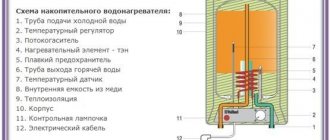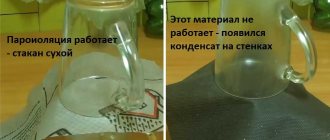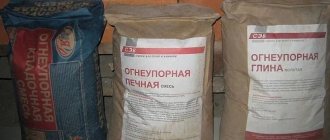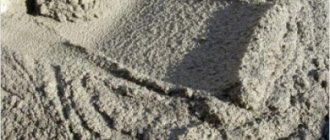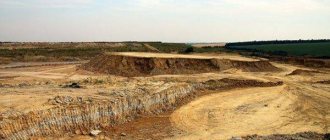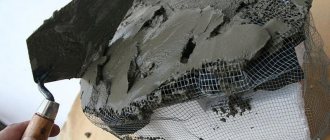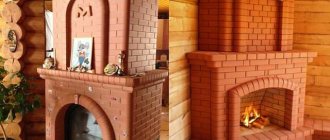From the author: I welcome you again, my dear readers! Today I would like to pay attention to the question of what kind of mortar the fireclay brick is placed on, and why it is needed in general. In itself, it is a peculiar mixture of fireclay powder and refractory clay. This synthesis of materials allows it to withstand temperatures of up to one and a half thousand degrees Celsius, but more on the benefits later.
More than once in my practice I have seen how a huge stove was built, which was used as a barbecue or grill, and the wrong connector was used during its installation. It did not have the same fire-resistant qualities, which led to the complete destruction of the entire structure. Naturally, the brick also deteriorated, which led to the largest possible loss of the client’s financial resources.
Now I will tell you how to make high-quality masonry mortar correctly and with your own hands, without the help of professionals.
Characteristics of refractory bricks
There are a lot of fakes of this type of stone on the modern Internet. In this regard, I immediately want to protect you and advise you to purchase it only in specialized stores, construction hypermarkets or other places where you can touch it and evaluate the quality.
The first thing you need to know is that it must be beige in color. The shade should not be faded or, conversely, saturated, this indicates a marriage or deception. Each brick weighs approximately three kilograms. The material must not have cavities or any other openings. The ingress of air can lead to a decrease in heat resistance and, therefore, lead to unusability of the product. The dimensions of the standard sample do not exceed 25 centimeters in length, 12 in width and 6.5 in height.
Unfortunately, you won’t be able to check his abilities in the store, so at least ask the seller for information on this issue. If he answers that the fireclay brick they provide for sale has high heat resistance and low thermal conductivity, then you can easily give preference to the type of material under discussion. This is exactly the product you need.

Source: teploguru.ru
Mixture for laying fireclay bricks
Ceramic stone is placed on red clay, while refractory stone is placed only on refractory clay. You can make masonry mortar yourself or buy a prepared mixture. It is also called fireclay mortar. Only soft water without dirt and oils should be added to the solution. The approximate consumption of the solution is as follows: 40 kg (three buckets) per hundred stones. We advise you to calculate the required volume in advance so as not to buy or prepare too much.
A mixture called “fireclay mortar” is easy to prepare: you need to gradually add a measured amount of water. Its quantity should be such that the final mixture is approximately as thick as sour cream. Mixing is done using a construction mixer or a drill with a special attachment. A concrete mixer can be used effectively for large volumes; one batch is done for at least five minutes.
The finished solution is left for 60 minutes, and then stirring is repeated. The mixture can become even stronger if about 15% cement is added to it (calculated from the original dry matter). After this, you can start laying out the stones. Mortar allows you to spend less time and effort on mixing the solution, but it also has disadvantages: strong shrinkage and lower strength compared to a mixture based on fireclay sand and kaolin clay. This makes the solution mixed with your own hands recommended for use.
Fireclay is soaked for a period of 12 hours to 3 days. You can replace kaolin clay with blue Cambrian clay. The clay from the bag is placed in a container and filled with water to the top; it requires regular stirring. After the expiration date, the clay must be passed through a sieve with a mesh size of 3 mm.
You should smell the clay; if there is no smell, then this is a good sign. And the presence of an unpleasant, pungent odor indicates the presence of additives.
After soaking and rubbing, fireclay sand is poured into it. You cannot use quartz sand and marble chips. In exceptional cases, you can take mountain sand, which does not contain foreign inclusions or silt. Before mixing, you need to take a sieve and sift this sand through it. Sand and clay should be taken in a ratio of 2:1.
Cases in which this will be useful to you
In most cases, the need for heat-resistant bricks arises among owners of private houses or summer cottages. Apartment residents do not need it, since fire safety regulations prohibit you from creating an uncontrolled open fire on the territory of a residential building. Alas, building a barbecue on a balcony or loggia is not the best idea.
This type of stone will serve you well when constructing stoves for heating a house, a chimney used for the same purpose, a permanent installation for a grill, or when planning an English fireplace that will show off on the central wall of your future home. It will create comfort and coziness for you, which will add warm and bright colors to your vacation. In addition to all this, don’t forget that on New Year’s Day you will have somewhere to hang festive socks so that Santa Claus will put sweets in them for your children.
It is not worth saving on material, because the quality directly depends on the price, and since buildings made of fireclay bricks are not cheap, their reconstruction will cost a lot of money.
The solution recipe that I will now tell you can also be used for repair work. It is quite possible that one stone may fall off inside the structure, which needs to be put in place using just such a mixture.
General concepts about lining
Lining is the lining of the internal surfaces of the furnace chambers, which are constantly in contact with open fire. The task of this facing layer is to carry out protective functions, to protect the outer walls from all kinds of thermal, mechanical, chemical and physical damage. Lining is made to protect not only household heating appliances - in the mining and metallurgical industry, this technology is widely used in powerful smelting furnaces of various designs.
In addition to the protective function, heat-resistant materials that line the internal surfaces of the firebox significantly reduce heat losses. However, there is also a “other side of the coin” - it is very important to correctly calculate the thickness of the lining, otherwise the furnace walls will not heat up well. And the heat will simply go into the chimney, and not into the rooms of the house.
Furnace lining can be done in various ways. The most suitable one is selected depending on the material from which the furnace is built, and on when it is decided to carry out the operation of laying the protective material.
So, the methods for creating a protective cladding are as follows:
- Lining internal surfaces with bricks or panels made of heat-resistant material with low thermal conductivity. In this way, the lining process can be carried out both during the construction of the furnace, and already in the finished heating structure.
- Application of various heat-resistant solutions to the internal surfaces of the furnace walls. This method is also used in ready-made heating devices or in brick ones during their construction.
- Installation of heat-reflecting screens - this lining method is effective for metal sauna stoves. If you use screens in other models of stoves, this can lead to a decrease in their efficiency, since the generated heat will not warm up the walls, but, being reflected inside the firebox, will go into the chimney pipe.
Protective materials for lining stoves, fireplaces and boilers are made from clay or crushed or processed rocks. They are divided into classes depending on their basis.
— “A” means materials made on the basis of silica.
- “B” - specially selected clay is used for the base of these lining compositions, bricks or panels.
— “C” is a combined lining made from several components that do not fit into class “A” or “B”.
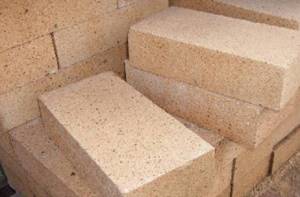
The most popular lining materials, apparently due to their availability and quite reasonable price, are bricks, blocks or mortars based on fired fireclay clay
- The most popular materials for lining heating devices are fireclay materials. This can be brick, panels or dry mixtures from which the mortar is made. Such materials belong to class “B”, since, in fact, fireclay is a special clay fired at very high temperatures, reaching up to 1500 degrees. The natural material brought to sintering is crushed, then bricks, panels are made from it, or it goes on sale in the form of a fine powder.
The composition of fireclay materials can also include additives from quartz or sandstone, as well as other rocks that are resistant to high temperatures. Fireclay materials are the most popular, as their quality and efficiency are time-tested. In addition, they have a relatively affordable price.
We suggest you read: Brick bathhouse, how to insulate walls
Brick prices
brick
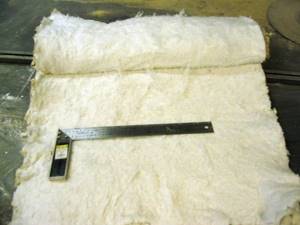
Kaolin wool is made from alumina and quartz sand
- In addition to fireclay and other solid materials intended for lining, roll, slab or sheet materials are used, which are installed as a gasket between the heat-resistant and outer brick layer of the masonry.
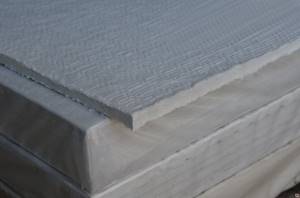
These materials include kaolin, basalt, vermiculite, mullite-siliceous and other products, for which a composition based on white clay is most often chosen as a binder. All of the listed materials can withstand temperatures of 1200÷1400 degrees.
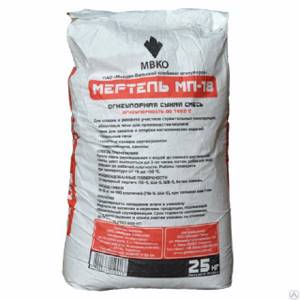
Such a dry mixture can be used both for preparing heat-resistant masonry mortar and for filling into technological cavities of masonry
- You can also make the lining with mortars from heat-resistant materials, which are applied to the surface of the firebox walls of finished furnaces, and are also used for laying refractory bricks during the construction of a heating structure (it is clear that ordinary masonry mortar will not always be appropriate here). In addition, free seams are filled with these powders, as well as some of those technological gaps and clearances that are intended for thermal expansion of metal structural elements.
Dry mixtures for the lining process are made from fireclay or cement enriched with special additives. An example is the refractory self-expanding cement RPTs M500.
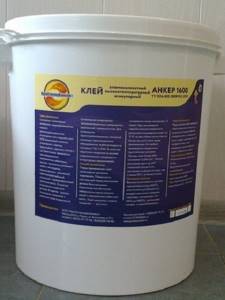
Aluminosilicate fireproof adhesive “Anker 1600” is very easy to use and reliable in use.
- Another material that can be used for the lining process is high-temperature aluminosilicate refractory adhesive, which is intended for gluing roll and panel materials, laying heat-resistant bricks, and also for applying to walls made of ordinary bricks. Heat-resistant compositions from different manufacturers are designed for a maximum heating temperature of 1400÷1600 degrees, which is quite enough to protect brick walls from exposure to open fire. The convenience of such compositions is that they dry quickly. For example, after lining the firebox with this material, the furnace can be operated within a day.
In addition to fire-resistant glue, today in construction stores you can find other one- and two-component compositions, most often produced in a paste-like consistency - these are heat-resistant mastics and coatings that can be applied both during the process of arranging the firebox and in a finished heating unit.
| Material name | Material density, kg/m³ | Maximum operating temperature |
| Fireclay (ready-made brick or mortar) | 1800-2000 | 1300 |
| Dense kaolin | 2400-2500 | 1400 |
| Vermiculite | 150-250 | 1090 |
| Mullite (matt/pure) | 3030 | 1600/1800 |
| Basalt wool | 100 | 750 |
| Regular kiln red brick | 1600 | 700 |
| Aluminosilicate fireproof adhesive | – | 1600 |
What solutions are strictly prohibited to use?
The overwhelming majority of ordinary people, who are trying to prove to everyone that they know more than others, argue that the basis of a viscous creature does not matter at all when laying structures that will be exposed to high temperatures. I hasten to protect you from the crazy thoughts of these savages and prove the opposite.
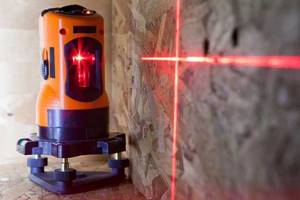
Source: jacekpartyka.com
These pseudo-builders claim that ordinary cement mortar, which we are accustomed to using when laying ordinary walls, will serve perfectly for many years. I can prove the opposite using mathematics and physics. Look here.
The melting point of cement is one and a half thousand degrees Celsius. This is the phase at which solid, one might say, concrete begins to turn into a viscous solution. The burning of wood produces thermometer readings at one thousand degrees Celsius. That is, we can safely say that this type of binder will be destroyed after a couple of hours of creating heat inside the room, and you definitely won’t get the long-awaited barbecue for May Day.
There is nothing to say about lime analogues, because the rates at which they turn into a liquid state are even lower.
A good way to lay fireclay on solutions of different recipes
The method is not very popular among professional stove makers; many criticize it for being excessive, unnecessary complexity and labor-intensive, but for an amateur it is often the only way to compensate for masonry errors.
Fireclay is a good thermal insulator, a very hard and stressed brick, it can successfully withstand high temperatures for a long time. But under one condition - gradual heating and cooling, thereby reducing the destructive effect of internal stresses. But in practice this is only possible for industrial furnaces.
The essence of the method is that the choice of which mixture the fireclay is placed on is determined by its location in the furnace. It is better to use different mortar formulations for the tray, side walls and roof of the firebox. This is inconvenient and will take three times longer to complete the job, but it gives good results. If you put everything on the same mortar composition, most likely, in a year you will have to reposition the firebox vault or the brick laying belt next to the ash pit.
In a home stove, you can extend the life of fireclay by varying the thickness of the bond seam and the composition of the masonry mortar. If the stove is designed for firewood, for example, for a small country house, the fireclay can be combined with one composition with 10% clay content and replace 15% of the sand with fine fireclay powder.
In the mortar for laying bricks in a bathhouse, used for laying rows under the heater and heating the steam room, it is better to reduce the fireclay content to a minimum and double the clay content, laying the fireclay “on the end” with dressing with ceramic bricks on clay mortar.
So what to do?
For laying fireclay bricks, a special clay mortar is used. Many of you have heard about it, some have seen it, and only a few have worked with it. Therefore, I will tell you about its features.
I recommend using so-called fatty samples of this type of mixture, since when they dry, they only crack a little. There is no escape from this, because you will not be able to achieve the most acceptable consistency. There is no standard in this matter, and we can only endlessly try to get closer to the ideal.
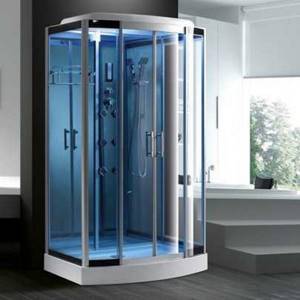
Source: dizainvsadu.ru
The clay should not be ordinary clay, which you found on the lake near your parents’ house, but fire-resistant. Even in ancient times, dishes like this were used to make dishes that hardened during heat treatment in the oven. It is light brown in color and quite hard in its normal state. Before purchasing, consult with friends who have encountered a similar problem about the place of purchase, so as not to end up with low-quality raw materials.
A little higher, I recalled well-wishers who do not have the slightest idea about this issue. Several times I came across articles in which it was written that a chimney can be made using standard solutions. This is true, but not all of it, but only its upper part. At a distance of one and a half meters from the place where the fire is concentrated, everything should be treated with a clay look. I'll talk about the consequences a little later.
Mortar compositions for laying various parts of the furnace
The thermal regime of each furnace element requires the use of its own solution. For example, it makes no sense to use the proportions of the composition of the fireclay lining bundle in the preparation of mortar for laying a brick chimney. Moreover, the laying of even simple stoves or fireplaces takes at least five to seven days, and the prepared solution during the day must be mixed as often as possible - interrupted and adjusted for moisture content.
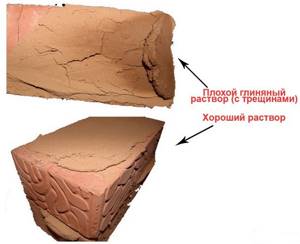
Clay mortar recipes for laying fireclay bricks
In the kiln business, the composition based on clay and cement-sand compositions is considered classic. Clay, due to its high water content, makes the solution soft and plastic. The seam is approximately the same, so it must be added when laying fireclay bricks in corner joints, in places where air is supplied and combustion products are removed.
For a colder ashtray and the lower row of fireclay adjacent to the pan, the amount of clay in the solution should be the maximum of the proposed recipes. Usually, in a mixture of two parts of cement, one part of clay and two parts of fireclay powder are added with a fraction of 1 mm to 0.1 mm.
If the seam turns out to be too brittle, add a very small amount of washed white sand to the clay, about 1/5 of the amount of clay, 1/10 of fine fireclay powder and 15-20g of laundry soap.

The clay is poured with a small amount of water with dissolved soap and chopped within an hour with a bayonet, sapper shovel or similar suitable tool, adding sand and fireclay in small portions. This procedure will make the clay “lighter” and more flexible, but the solution must be used within no more than 3 hours.
Mortar for laying chamotte walls
Laying fireclay on the main walls of the firebox should be done no more than two rows per day, and it is better to leave the first row for a couple of days to level and settle the seam. To prepare the mixture, the previous method is used, but it is better to completely exclude sand from the composition. It is advisable to lay the first three rows of the firebox using a mixture with the addition of liquid glass, and increase the content of fireclay powder at least twice, this will increase the strength and rigidity of the seam, but will increase the tendency for cracks to form.
As with ceramics, the durability of the masonry and the strength of the seam depend on the quality of the clay. You cannot take very fatty and plastic clay; it has a high content of hydrated silicon and iron compounds, which has a bad effect on the further condition of the masonry, shrinkage increases and cracks appear.
Skinny types of clay are not suitable for mortar; they will not shrink, but there will be no strength either; the mortar will crumble within a couple of weeks after hardening. A reasonable balance can only be determined by practical tests with drying and heating.
Advice! The degree of fat content of the clay can be practically checked by immersing a dried lump of wet clay in soft water and trying to knead it with your fingers.
Oily clay will go into solution, like soap, while thin varieties will disintegrate very poorly even under the influence of mechanical forces.
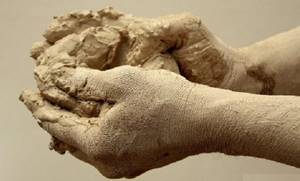
The difficulty of preparing the mixture for masonry is associated with the need to maintain the required consistency of the solution. Sodium silicate gives the mixture increased adhesion, but impairs its ductility. Most often, the viscosity of the composition is selected experimentally so that the height of the seam under the weight of the fireclay brick does not decrease by more than 10 mm.
Approximately the same composition of the solution is used for a brick chimney, but with a more viscous consistency.
Mortar for laying the firebox tray
The working conditions of fireclay bricks require increased heat resistance of the joint with minimal seam sizes and maximum adhesive strength. Most often, fireclay bricks placed in the base of the firebox are glued with a specific solution from a mixture of liquid glass - 1 part, fine powder from sawdust brick - 5 parts, fireclay clay - 2 parts.
The consistency of the solution is creamy, viscous mixtures are also good, but they will not give the minimum dimensions of the seam, and this is important. To check the quality of adhesion of the binder, the brick is moistened with water and a small portion from the batch is thrown onto the end. Accordingly, with the correct consistency and proportions, the mortar for fireclay bricks should not drain or fall off the brick surface.
Use of compositions for laying industrial fireclay
The industry produces a ready-made dry mixture for preparing a batch for fireclay bricks. This mixture is called mortar and is a mechanical mixture of the following components:
- Fireclay dry dust, as a rule, is obtained by firing refractory materials at factories; it is more active in adhesion than powder from grinding substandard fireclay bricks;
- Dry ground white bentonite clay, with a high content, up to 25%, of alpha aluminum oxide;
- Dry sodium silicate powder or liquid glass;
- Plasticizing additives based on water-soluble polymers.
The average consumption is about 20 kg per hundred fireclay bricks. With the correct consistency it produces a seam of 6-8mm.

Production of a specialized mixture
To form a clay solution you will need three required components:
- fire-clay,
- sand. It is this that is an excellent leavening agent and is used in all such batches,
- water. There is a popular belief that to achieve maximum quality, it is best to use rainwater. I have never tried this, because I think that in the twenty-first century, collecting rain is at least a little wild. However, I also cannot say that there is no difference. In general, as for me, ordinary water that flows from the tap is enough.
When synthesizing, you should remember simple proportions. Clay and sand are poured in a one to one ratio and mixed thoroughly to create a homogeneous mass. Only after this is it possible to add liquid to achieve the desired level of viscosity of the substance. It costs about one-fourth to pour the volume that you have already mixed. The consistency should resemble sour cream. In this case, you will get a high-quality result.
If you decide to collect rainwater, write in the comments under this article or on our social media pages about the results. Is it really better?
Quality of sand and clay

To prepare the solution you need to take clean and very fine sand.
They take very clean and finest sand, most often it is mountain or river sand, which is sifted through a fine sieve to exclude plant inclusions and pebbles. Only experienced specialists can determine by touch what the clay is like and whether it is suitable for the job. But there are several ways to do this that are suitable for use by beginners.
To determine its quality, clay is placed in a bucket and filled with water, and then mixed so that the mixture has a consistency similar to liquid sour cream. Before the clay settles to the bottom, they lower a freshly planed board into the bucket, take it back and see how much clay has stuck to it. If the layer is less than 1 mm, this clay is thin and must be mixed with fatter clays. If the layer is very thick, sand must be added. Clay with normal plasticity will stick to the board unevenly and about 2 mm thick.

Dimensions of fireclay bricks.
The longest and most reliable way to determine the quality of clay will require dividing it into 5 portions, each with a volume of 1 liter. The first portion is mixed with water. Add 1/10 of a liter jar of sand to the second, 1/4 of the jar to the third, 3/4 to the fourth, and a full jar of sand to the last. Mixing everything prepared separately until the clay sticks to your hands, small balls are made from each mixture, rolling some of them into flat cakes. The clay dries for about 10 days in a dry and draft-free room. The mixture that is considered suitable for joining masonry is the one from which the cakes are the least likely to crack, and the balls do not break when falling from a meter height to the floor.
If you don’t have time to wait 10 days, you can arrange a slightly less accurate strength test of the mixture. The balls are placed on a flat surface and, using a flat board, begin to be slightly pressed down as evenly as possible. The balls that immediately crumble are made of lean clay; if cracks practically do not appear, the clay is oily. A combination that is considered normal and suitable is when the balls are covered with small cracks (when compressed) by about a third of their size.
Return to contents
Possible consequences
Certain errors, of course, are acceptable, but a disregard for the production of a special heat-resistant solution leads to catastrophic consequences. Improper mixing can cause severe cracks or complete looseness of the brick-to-brick connector. Subsequently, you will see how the entire structure deforms and collapses right before your eyes.
Quite a large number of owners of stoves, pipes, barbecues and grills, built by irresponsible, disgusting craftsmen, asked for help. But all we could do was disassemble and reassemble the entire structure.
It was unbearably painful to see the look of a man who had already marinated the meat and realized that he would have to fry it over a regular fire. It became even worse at the moment when he turned his head, and part of the chimney collapsed inside the built fireplace. It was doubly offensive because it was not Santa Claus who broke it.
How to choose a brick
Remember: the darker the color of the brick, the greater temperature changes it can withstand without losing its qualities. Pay attention to its appearance - it should be smooth, without cracks, scratches, or dents. It is very important to check it with a hammer. If a brick crumbles after an impact, it is a very bad material. If it simply disintegrates, everything is fine, such material is suitable for construction.
As a rule, there are markings on the brick. To build a stove or bathhouse, we need a material with the letter “Ш” - this is fireclay fireproof. This is extremely important, because there are several types of bricks, and each is suitable for a specific type of building.
Many people ask the question: which is better? And although red brick is in most cases inferior to fireclay, it must be taken into account that the latter is much more expensive. It is extremely unprofitable to use it for large volumes of construction.
A little personal experience
Friends, I have repeatedly worked with the construction of elements that were later used for heating with wood. Based on my experience, the biggest mistake that owners make is saving money. I was glad that they did not decide to save money on professionals, but I was very disappointed in the quality of the materials they purchased.
All work related to the construction of heat-resistant elements can be done with your own hands. It’s better to save your money and don’t overpay to expensive builders, but you can’t skimp on fireclay bricks and fireclay. No matter how cool the master is, he will not be able to make candy from underground raw materials. You can blame him later, but I am sure that you will be warned about this outcome of events.
Friends, remember my advice and save your savings by saving on the right things, and not on those that you vitally need! Warmth, comfort and speedy completion of the renovation!
The difference between chamotte and ordinary ceramic bricks
Fireclay brick cannot be confused with any other block, even with other refractories. Mostly yellow or even light yellow in color, with a whitish tint. The main difference between fireclay bricks is the high content of aluminum oxide in various chemical forms and modifications.
In comparison with ceramic bricks, with a high content of iron oxide and silicon oxide, fireclay bricks have their own characteristics that affect their durability:
- The surface of the block is highly porous, but these pores are very small; the solution penetrates poorly into them, but moisture and air penetrate well;
- The coefficient of thermal expansion of each brick is strictly individual, which will require difficult and painstaking selection of the composition of the mortar for masonry;
- The refractoriness and ductility of fireclay bricks largely depends on the operating mode of the furnace, and not on the composition of the mortar or the method of laying.
Advice! For the lining of one furnace, you cannot use fireclay from different batches or a set of randomly selected bricks; in extreme cases, different types can be converted into broken or fireclay powder
.

How to improve the quality of the solution
A properly prepared solution does not require any additional additives - it will be extremely durable even without them. However, if you still doubt its strength, it is recommended to add table salt. Its quantity should not exceed 150 grams per bucket of solution.
It is also reasonable to improve the ductility of the masonry. To do this, it is recommended to add no more than 1-3% of liquid glass from the total mass. During installation, be sure to ensure that otherworldly objects - nails, glass fragments - do not get into the solution. The masonry layer should be no more than 3 mm.
So, in this article we learned that there are many types of bricks. Fireproof is best suited for construction:
- ovens;
- baths;
- barbecues and other structures that are constantly exposed to high and very low temperatures.
In addition, it has other qualities that are extremely important for construction. Firstly, it has more attractive aesthetic qualities, and secondly, it is much stronger, and therefore will last much longer with proper use.
However, we should not forget about the disadvantages. As already mentioned, it is more difficult to work with - you can’t do without an angle grinder with a diamond blade during installation. In addition, you need to be able to choose the right brick, because sometimes you can get poorly scorched specimens, and sometimes too much. Therefore, when purchasing, it is best to enlist the help of a specialist.


